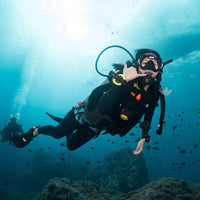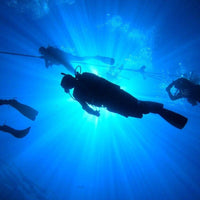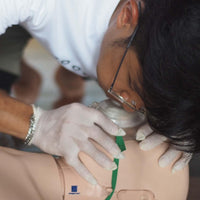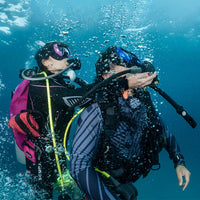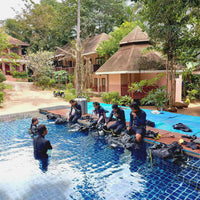PADI Advanced Open Water: Your pass to enjoy diving anywhere in the world with a buddy (max. depth of 30 m)!
2 days | 5 Adventures Dives
Level up your diving skills!
As an already qualified Open Water Diver, the next step is the PADI® Advanced Open Water course, which, when completed, will give you a license to dive to a maximum depth of 30m.
The PADI® Advanced Open Water course is about improving your underwater skills and learning new techniques, as it is about having more fun!
Who should attend the Advanced Open Water course?

To apply for the Advanced Open Water course, you don't need to be an "experienced" diver. The course is built to leverage and complete the skills you learned during the Open Water courses.
So this course will be a perfect fit if you have just finished your Open Water license or registered a few dozen dives.
Let's earn your PADI® Advanced Open Water Certification!
Our highly-trained PADI Instructor from Coral Grand Divers will teach you specific skills and knowledge, supporting you every step of the way.
| Prerequisites |
Be a PADI Open Water Diver or equivalent, medically fit for diving (Read the PADI Medical Form to check that there are no issues. If you answer 'NO' to all the questions then you are OK to start your diving course and there is no need for you to have a medical check.
If you answer 'YES' to any questions, please let me know. In that case, there are some additional questions on page 2 and a medical check-up may be required before starting your course) |
| Total time commitment |
6 to 8 hours to the eLearning program; 2 days for 5 training dives |
| Minimum age |
15 years old or older (or 12 years old for Junior Open Water Diver)
|
| Depth |
Maximum allowed depth 30 m |
Koh Tao Advanced Open Water Diver Course package includes:
- 5 training dives
- Insurance coverage
- Rental dive equipment
- Use of Dive Computers during the course
- PADI e-material
- PADI e-card on completion
- Complimentary refreshments, coffee, fruit, and snacks on our diving boat
During the Advanced Open Water course, you will take two compulsory dives, a Deep dive and an Underwater Navigation dive, plus any three adventure dives of your choice.
For each of the five adventure dives you complete during the course, you must read a chapter in the E-Learning manual and complete the corresponding knowledge reviews online.
One of our highly-trained Diving Instructor will teach you how to:
- Develop new skills and build confidence
- Dive as deep as 30m (100ft)
- Try out different specialties while gaining experience.
No classroom, swimming pool, or final exam, only fun and adventure dives in Koh Tao!
Let's go for Five exciting Adventure Dives!

✔️Maintain neutral buoyancy.
✔️Evaluate the number of kick cycles and the time required to swim underwater at a normal, relaxed pace of approximately 30 meters.
✔️Navigate to a predetermined location and return within 15 meters of the starting point, guiding using natural references and estimated distance measurement (kick cycles or time). Surface only if necessary to verify direction or location.
✔️Position and handle a compass underwater to maintain an accurate heading while swimming.
✔️Navigate without surfacing to a predetermined location, return within 6 meters of the starting point using a compass, and evaluate distance measurement (kick cycles or time).
✔️Swim a square or rectangular pattern underwater, beginning from a fixed location and returning within 8 meters of the starting point using a compass.
Deep (Mandatory)
✔️With a buddy, plan and manage gas usage, including turn, ascent, and reserve pressure.
✔️Establish no stop-and-dive time limits.
✔️Descend using a line, wall, or sloping bottom.
✔️Compare changes in color at the surface and depth.
✔️Compare a dive computer reading to another diver's depth reading.
✔️Ascend at a rate not to exceed 18 meters/60 feet per minute using a dive computer.
✔️Make a safety stop at 5 meters for at least three minutes.
There are three elective dives that you get to choose from:
The essential skill for any confident scuba diver is buoyancy. Improving your buoyancy will give you more control and improve your air consumption.
Learn how to streamline yourself and your equipment, use your lungs more to control descents, adjust your trim, and focus on swimming, body position, and hovering.
Night Adventure Dive
Learn how to communicate at night and handle a dive torch, as well as entry and exit techniques. You will also learn to navigate a reciprocal heading, a skill you have mastered during the Underwater Navigation dive, but this time you will do it in the dark! Explore the Ocean at night with lots of new cool stuff to spot, including the extraordinary natural phenomenon, Bioluminescence.
Experience the excitement of diving into a shipwreck. Learn how to safety plan and execute a wreck dive deeper than 18 meters on the HTMS Sattakut.
Learn more about underwater life, symbioses between species, underwater ecology, aquatic plants, and animal habitats.
Learn how to identify fish, their family groups, and specific species.
We will also spend time discussing and practicing responsible dive practices to avoid adverse effects on the underwater environment.
This dive teaches you specific knowledge about diving off boats, including terminology, typical exit and entry points, and techniques for correctly deploying a surface marker buoy.
Your Instructor will teach you how to shoot stills and understand the basics of exposure, focus, and composition.
Learn how to use a lift bag, bring an item to the surface, tie various knots, and perform an underwater search.
Knowing when and how to administer Oxygen is a valuable skill in a diving emergency. During this course, you will learn to recognize different injuries and illnesses necessitating Oxygen administration.
Get PADI Credit!
Each Adventure Dive in the PADI Advanced Open Water Diver course may credit toward the first dive of the corresponding PADI Specialty Diver course.
Make it COMBO with the additionnal Enriched Air Nitrox Course!
PADI Advanced + Nitrox Specialty Course at a discounted price !
In a hurry or want to take your Enriched Air Nitrox Course (EAN) while having your Advanced Open Water Course? It's possible by choosing the Combo Advanced + Nitrox Course option.
It's a great way to gain two certifications in the same timeframe you need to complete the Advanced course! Spend longer time underwater by learning how to analyze Enriched Air fills and plan dives on Nitrox using a dive computer.

During this combo course, you will experience one dive with Nitrox Tanks. In only two days, you will be double certified with Advanced Open Water Diver Certification + Enriched Air Nitrox Specialty Certification!
Combo AOW Diver Course + EAN Specialty package includes:
- 5 training dives
- Insurance coverage
- Rental dive equipment
- Use of Dive Computers during the course
- PADI e-learning AOW + PADI e-learning EAN
- PADI e-card for AOW Diver certification + EAN Diver certification on completion
- Complimentary refreshments, coffee, fruit, and snacks on our diving boat
Be ready to see more, enjoy more and smile bigger!
What comes after the PADI® Advanced Open Water course?
During the Advanced Open Water course, you will experience five PADI specialties, giving you some ideas for additional ones to explore. Once you are ready to move even further, the PADI Rescue Diver course is the next step of your diving training adventure.

Any concern? Don't worry. We are here to support you and answer your questions.
You have not dived for a while and feel that your knowledge and skills are rusty.
We suggest you start with a Refresher Course in our on-site pool.
This quick course will re-visit your dive theory/safety and will include essential dive skills circuit, diving hand signals, and equipment setup.
By the end of your refresher, you'll feel more confident to enjoy your training dives.
Get in touch to arrange your refresher today!
IMPORTANT! -Flying after Diving
When planning your diving trip and your journey toward your destinations, always remember that you must not fly directly after scuba diving. It accentuates the risk of having decompression sickness.

The PADI guidelines are to NOT FLY during a 12 hours interval after a single dive and 18 hours after multiple dives. As often when it comes to scuba diving, take a conservative approach to safety, and whenever possible, avoid flying the next 24 hours after a dive.
If you intend to do multiple dives on different days during your trip, consider buying your own dive computer, as it will calculate the optimal time to fly based on your diving history.
Even more than other outdoor sports, diving is weather- and sea-dependent. Be aware that some sites might be inaccessible on certain days and that diving trips might be canceled due to dangerous conditions.
Luckily, Thailand has a fantastic climate almost all year round and this happens very rarely.


